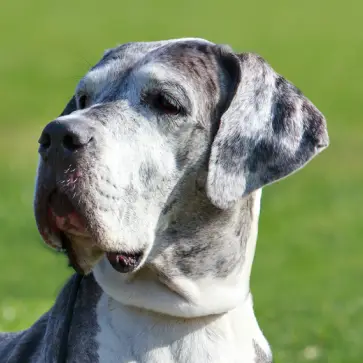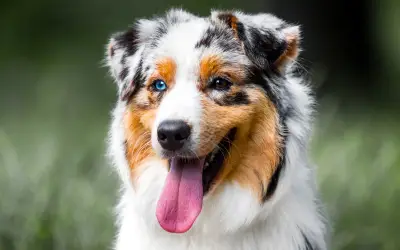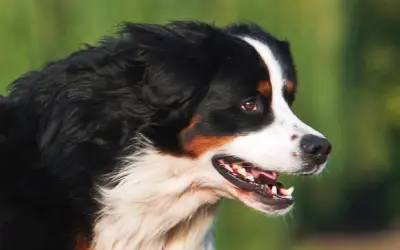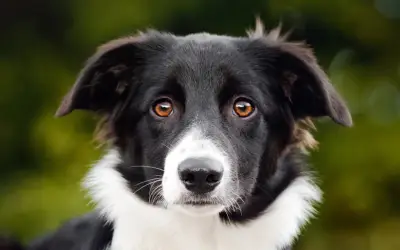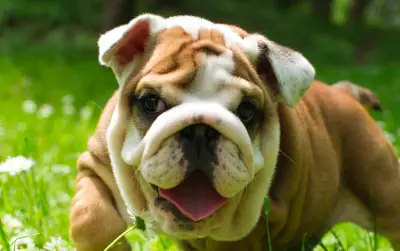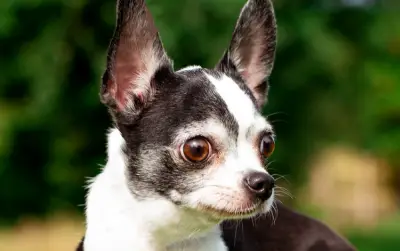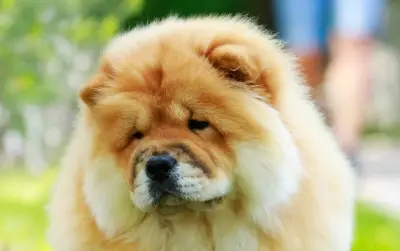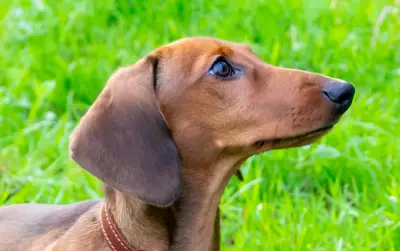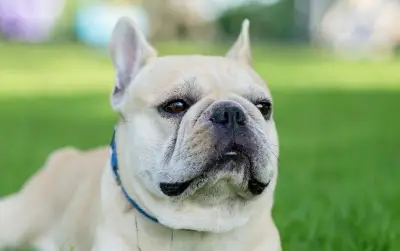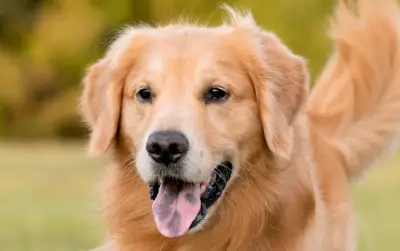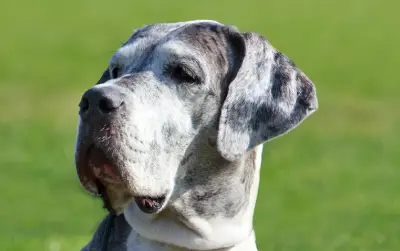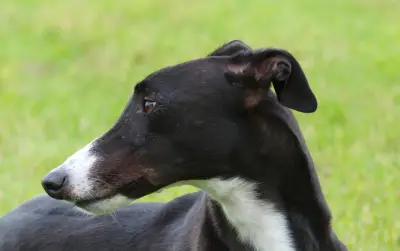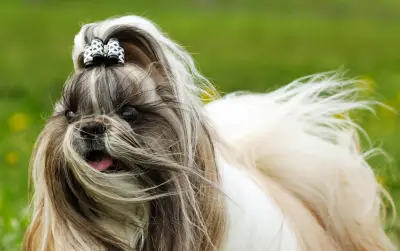When you think of large dogs, the towering Great Dane might be the first breed to come to mind. Nicknamed “the Apollo of dogs” because their powerful, athletic build and majestic stature calls to mind the Greek god of the sun, Great Danes are imposing figures in the dog world. They’re quite smart and have a gentle, affectionate nature, which makes them great family pets even in households with young children. In fact, in 2023, the Great Dane landed at a respectable number 19 on The American Kennel Club’s list of the year’s most popular dog breeds.
If you’re thinking about adding a Great Dane to your household, keep reading. This guide provides all the information you’ll need to understand this giant breed, including size expectations, training and grooming essentials, veterinary care guidelines and more.
They’re quite smart and have a gentle, affectionate nature, which makes them great family pets even in households with young children.
Great Dane Facts Overview

Male: Weight: 140-175 lbs; Height: 30-32 inches
Female: Weight: 110-140 lbs; Height: 28-30 inches
Usually
Usually, especially if raised together
Yes
People-pleasing nature makes training a breeze
Weekly brushing to reduce shedding
7-10 years
Friendly, gentle, affectionate
Easygoing, eager to please
Black, white, black and white, blue, brindle, fawn, silver, harlequin, mantle, merle
Adjustable; Fits most dogs

Great Dane Size and Physical Characteristics
Great Danes are one of the largest and tallest dog breeds in the world. When they stand on their hind legs, these giants are often taller than a person. Adult males typically stand between 30 and 32 inches at the shoulder and weigh between 140 and 175 pounds. Although smaller in stature, females can attain a height of 28 to 30 inches and weigh between 110 and 140 pounds.
This powerful breed is known for its regal appearance, which includes a long, well-defined rectangular head, a square muzzle and expressive features. To meet breed standards, a Great Dane’s body and legs should be sturdy and well-proportioned, and it should have a high, tapered tail.
A Great Dane’s coat is short, thick and glossy, with colors that run the gamut from solid black or white to brindle, merle and fawn. Some dogs may have striking harlequin patterning, which consists of a white background with black or merle patches spread across the entire body.
Training Tips and Techniques
Because of the Great Dane’s massive size and exceptional strength, misbehavior such as pulling and jumping can be especially problematic. With early training and socialization, owners can curb these behaviors before they cause problems. Fortunately, although some dogs can have a stubborn streak, most Great Danes are eager to please, which makes training them easy. Additionally, a GPS wireless dog fence is a wonderful training tool that can hep ensure a Great Dane’s safety.
Training typically falls into three basic categories: puppy training, obedience training and advanced training.
Puppy Training
Training during a puppy’s early months creates a foundation for promoting good behavior throughout its life. Once your veterinarian indicates it’s safe to do so, begin introducing your puppy to new people, animals, locations, objects and experiences. This exposure helps build your puppy’s confidence and can help you detect problematic behaviors so you can address them early. A knowledgeable, reputable dog trainer can provide advice and guidance during this crucial stage.
When your puppy first comes home, which should happen at about the age of 8 to 16 weeks, you should begin or continue the housebreaking process. Be patient, because it can take up to 6 months for your puppy to be fully housebroken, and success requires patience and consistency.
Many experts recommend crate training to aid in housebreaking a puppy. Your puppy’s crate should be a safe space, so create a positive association by offering treats, interactive toys or slow feeders when your pup is confined. For safety, always remove your pet’s collar before inviting it into its crate.
Training a puppy to walk well on a leash is also essential, particularly for giant breeds that can be difficult to control. You can start leash training when your pup is about 3 months old. Consider a front-attaching harness and a 6-foot leash for maximum control, and stay away from shock or prong collars, which can make your puppy fearful and hinder the training process.
Obedience Training
Obedience training is essential for your dog’s safety and comfort and for ensuring your dog can safely and comfortably interact with other people and animals. Whether you embark on training yourself or hire a trainer to help, it’s important for your dog to learn basic commands, such as:
- Sit
- Stay
- Come
- Down
- Focus
- No
- Heel
- Wait
Great Danes are people pleasers, so they thrive on positive reinforcement. Whether you’re teaching your dog basic commands or tackling more advanced tricks to show off to friends and family, keep your training methods consistent and positive. Rewards such as treats, toys and praise can be great motivators, but be careful not to overdo it when handing out food. Using a portion of your dog’s mealtime kibble in place of training treats can reduce the risk of overfeeding or stomach upset.
Remember, having a well-behaved dog involves a lifelong reinforcement of learned commands, so training is an ongoing process throughout your dog’s life. To achieve the best results with your pup, keep sessions fun and positive, and always use a calm, assured voice when issuing commands.
Advanced Training
The Great Dane is a working breed originally bred to hunt wild boar, so these dogs love to have a purpose. Advanced training in sports such as agility, dock diving or flyball can provide physical and mental stimulation to healthy adult Great Danes. Older or ailing dogs may also benefit from advanced training in lower-impact sports, such as scent work or tracking.
Because growing puppies are at risk for orthopedic injuries, they should never participate in activities that involve jumping or strenuous running. Typically, a Great Dane reaches maturity by age 2, at which point these activities are generally safe.
It’s important to get your veterinarian’s approval before your dog begins advanced training for any high-impact activity, and reputable trainers require dogs to be up to date on vaccinations to participate.
When engaging in advanced training programs such as agility, expect to practice learned activities for about 15 to 20 minutes each day. Although Great Danes love praise and affection and typically enjoy agility and other sports, rewards such as treats or toys can help reinforce desired behaviors. Although competition may be the end goal for some owners, whether you compete or not is up to you.
Great Dane Grooming and Haircut Styles
Great Danes have short, smooth coats, so they’re typically low-maintenance and don’t require haircuts. Occasional baths and weekly brushing keeps their fur clean and glossy and can help reduce shedding. During their peak shedding season, daily brushing may be needed. However, this typically only happens one or two times a year.
For best results, use a medium-bristle brush or a rubber grooming glove. However, brushing with a slicker brush before bathing can also help loosen dirt and debris.
You should also clip your dog’s nails regularly. Overgrown nails can cause pain and may result in difficulty walking.
If you prefer professional grooming services, look for a facility that can accommodate the bathing needs of giant breeds.
Great Dane Health
Like many large breeds, Great Danes are prone to certain health conditions, which can affect both their longevity and quality of life. For example, gastric torsion, commonly referred to as bloat, is considered one of the leading killers of these gentle giants. This acute condition, in which the stomach twists and distends, cutting off the blood supply, requires immediate surgical intervention. Consequently, owners should recognize the symptoms, which may include:
- Retching
- Drooling
- A firm, swollen belly
- Panting, restlessness and other signs of distress
Feeding your dog small meals throughout the day and avoiding strenuous exercise at mealtimes can reduce the risk of bloat. Additionally, preventive surgery known as prophylactic gastropexy, in which the stomach is tacked to the abdominal wall, may prevent serious side effects from this condition.
Great Danes are also susceptible to other health issues, including cardiomyopathy, autoimmune thyroiditis, eye disease and bone cancer. Orthopedic conditions — notably hip dysplasia — are also common in the breed due to the rapid growth puppies experience during their first year.
To reduce the risk of these and other health problems, it’s important to get a puppy from a reputable breeder and establish regular veterinary care with a trusted provider. As your dog ages, regular checkups and blood work are crucial for maintaining good health. Breed-relevant medical screenings may also help detect conditions early, when they’re more easily treated. These tests may include:
- Echocardiograms
- Hip X-rays and other diagnostic imaging
- Thyroid screenings
- Eye exams
When choosing a veterinary provider, look for someone who can accommodate the needs of a Great Dane. Not all practices have the right equipment to perform X-rays, surgeries and other procedures on dogs this large. Additionally, medical care — particularly medications — may be more expensive for giant breeds, so factor that into your budget.
Because Great Danes are too heavy to lift, it’s also important to consider how you’ll move your dog if it becomes incapacitated. Keeping a sturdy stretcher on hand can make it possible for two people to load a large-breed dog into a car for transport to a veterinarian in an emergency.
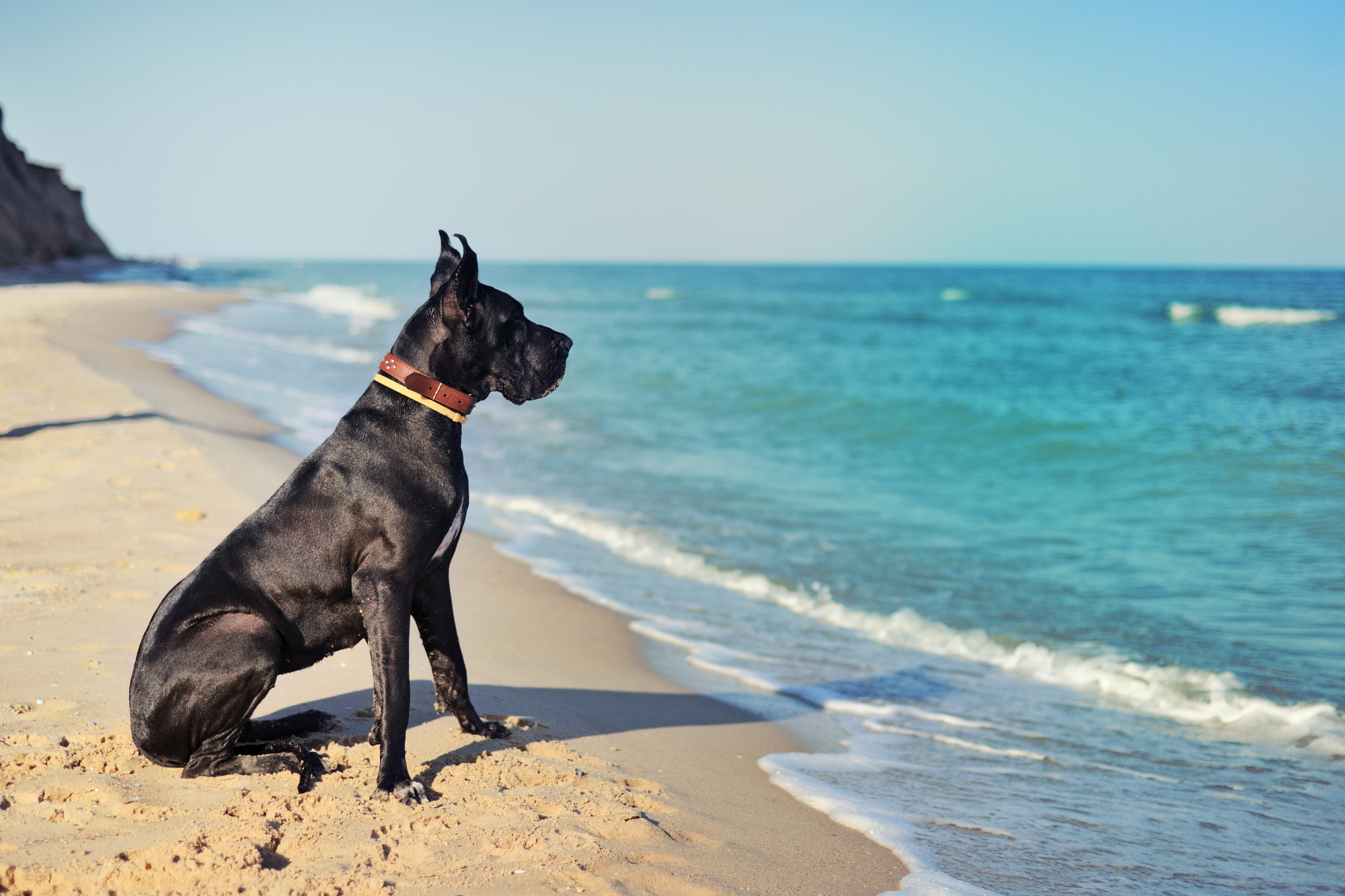
Great Dane Feeding and Nutrition
Choose a high-quality dog food designed for large breeds to keep your Great Dane well-nourished. Because nutritional needs change with age, always opt for kibble that’s appropriate for a dog’s life stage, whether that’s puppy, adult or senior. If your dog has a sensitive stomach or skin or other chronic conditions, finding food that caters to these special needs can help provide relief.
To reduce the risk of life-threatening bloat, Great Danes may benefit from several small meals rather than one or two large feedings each day. It’s also important to avoid strenuous exercise around mealtimes.
Although human food can be a tempting treat, avoid giving your dogs table scraps, and never feed your pup high-fat items or cooked bones. Ultimately, a balanced diet designed for a Great Dane’s size and energy levels is your best bet for keeping your dog healthy.
Exercise and Mental Stimulation for Great Dane
Great Danes are moderately active dogs that require daily activity. Ideally, you should take your dog for two to three long walks each day. The pace and length of those walks should be determined by your pup’s personality and energy level and by what you can comfortably fit into your daily schedule. This breed, originally bred to hunt wild boar, loves to sniff, so interactive walks, particularly in new locations, can also provide mental stimulation for your pet.
Allowing your pet to be off leash in the yard, while visiting friends, etc., is a great way to let a dog be a dog but it’s important to keep them safe. Training your dog to stay inside a GPS dog fence allows a Great Dane to enjoy off leash time outdoors, while ensuring their health and safety.
Puppies may need shorter, more frequent walks until they reach maturity. Short walks can also benefit senior dogs, ailing animals and pets with mobility issues by reducing stiffness and providing mental stimulation. However, you should always consult your veterinarian before beginning a new exercise regimen with a dog that has health issues.
Larger breeds can be prone to joint injuries, particularly as puppies, so it’s important to limit exercise when they’re young. For that reason, you’ll probably want to avoid long or strenuous hikes and leave agility activities that involve jumping for when your dog is fully grown. Instead, opt for short walks and structured playtime several times a day.
For mental stimulation, healthy, active dogs may also benefit from sporting activities, such as agility exercises and flyball. However, interactive toys, including slide puzzles and snuffle mats, which hide treats or food, can be a great way to engage your pet and prevent destructive behaviors due to boredom.
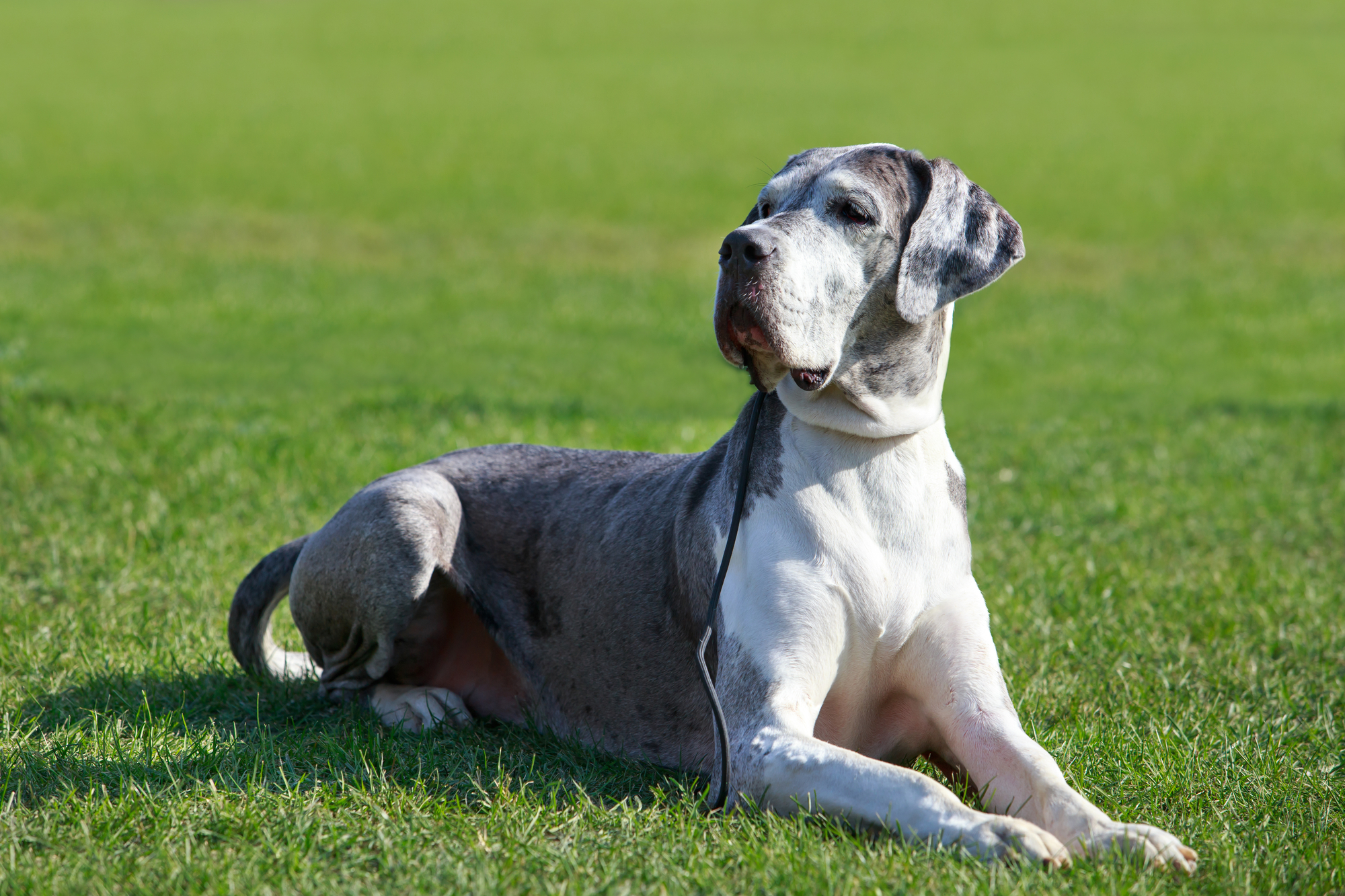
Living With a Great Dane: What to Expect
Great Danes are loyal, affectionate dogs that make wonderful, watchful guardians despite their sweet nature. They’re friendly to both humans and other animals, and when properly trained and socialized, they’re a great addition to a multi-pet household. Great Danes are also patient and gentle with children of all ages. However, they can quickly become a handful without proper exercise and mental stimulation.
Great Danes take up a substantial amount of space. As a giant breed, they need bigger beds, bowls, treats and toys, so they may not be well-suited to an urban apartment or small home. They also love to roam, so a house with a fenced-in yard is a plus. Inside, be sure to keep breakable items up high as wagging tails can easily knock them over. Plus, because of their giant-sized needs, this breed can be expensive; food, medications and toys for large dogs add up.
Because Great Danes are so social, they require a lot of human attention and affection. If you’re away from home a lot and can’t take your dog with you, a Great Dane may not be the best breed for you. However, if you have the time to properly train and care for a Great Dane, this breed will pay you back in love and loyalty, making adding it to your family a rewarding experience.
Great Dane FAQs
View all FAQsAre Great Danes good with children?
Because of their gentle, friendly nature, Great Danes are good with children. However, because of their enormous size, they can accidentally knock down or injure small children when roughhousing. Kids should be taught to play calmly with dogs, and interactions with young children should always be supervised.
How much exercise does a Great Dane need?
The amount of exercise a Great Dane needs depends on its life stage, personality and overall health. Healthy adults typically need two to three long walks each day, while puppies and seniors may need shorter, more frequent walks. Your veterinarian can help you determine the appropriate amount of exercise for your dog’s individual needs.
What are the grooming requirements for a Great Dane?
Great Danes have short, sleek coats, which can be kept clean and healthy with weekly brushing and occasional baths. During peak shedding season, which can occur once or twice a year, these dogs may require daily brushing. Nails should be clipped regularly. For professional grooming, look for a groomer who can accommodate giant breeds.
Is the Great Dane easy to train?
Most Great Danes are eager to please, so training them is easy. However, some individuals do exhibit a stubborn streak. For best results, use positive, consistent techniques and a calm, firm demeanor.
What are the common health issues for a Great Dane?
Common health issues for a Great Dane include gastric torsion (bloat), hip dysplasia, cardiomyopathy, autoimmune thyroiditis and bone cancer. Regular veterinary care and an awareness of symptoms can help detect these issues earlier so you can begin treatment.
How long do Great Danes typically live?
The average lifespan of a Great Dane is between 7 and 10 years. However, some individuals may live to be as old as 13 or 14. A dog’s longevity may depend on genetics, lifestyle, nutrition and regular veterinary care.
Do Great Danes get along with other pets?
Great Danes are friendly dogs that typically get along well with other animals, including cats and small dogs, particularly if they’ve been raised alongside them.
What is the ideal living environment for a Great Dane?
Because of their size, Great Danes need plenty of space. A home with a large fenced-in yard and owners who are home a lot is ideal. Additionally, many apartments and planned living communities have weight limits for pets, so be sure to check with your landlord or homeowners’ association before bringing home a puppy.
Are Great Danes suitable for first-time dog owners?
Great Danes are powerful animals that can quickly get out of hand if they don’t receive proper training and socialization. Consequently, they may not be the best breed for first-time dog owners. However, first-time dog owners who are willing to put in the time and effort to train and socialize a puppy may find having a Great Dane rewarding, as this is a loving, loyal breed.
What should I feed my Great Dane?
Dogs’ nutritional needs change as they age, so choose a high-quality dog food designed for large breeds. Make sure the kibble you choose is appropriate for their life stage, whether that’s puppy, adult or senior.
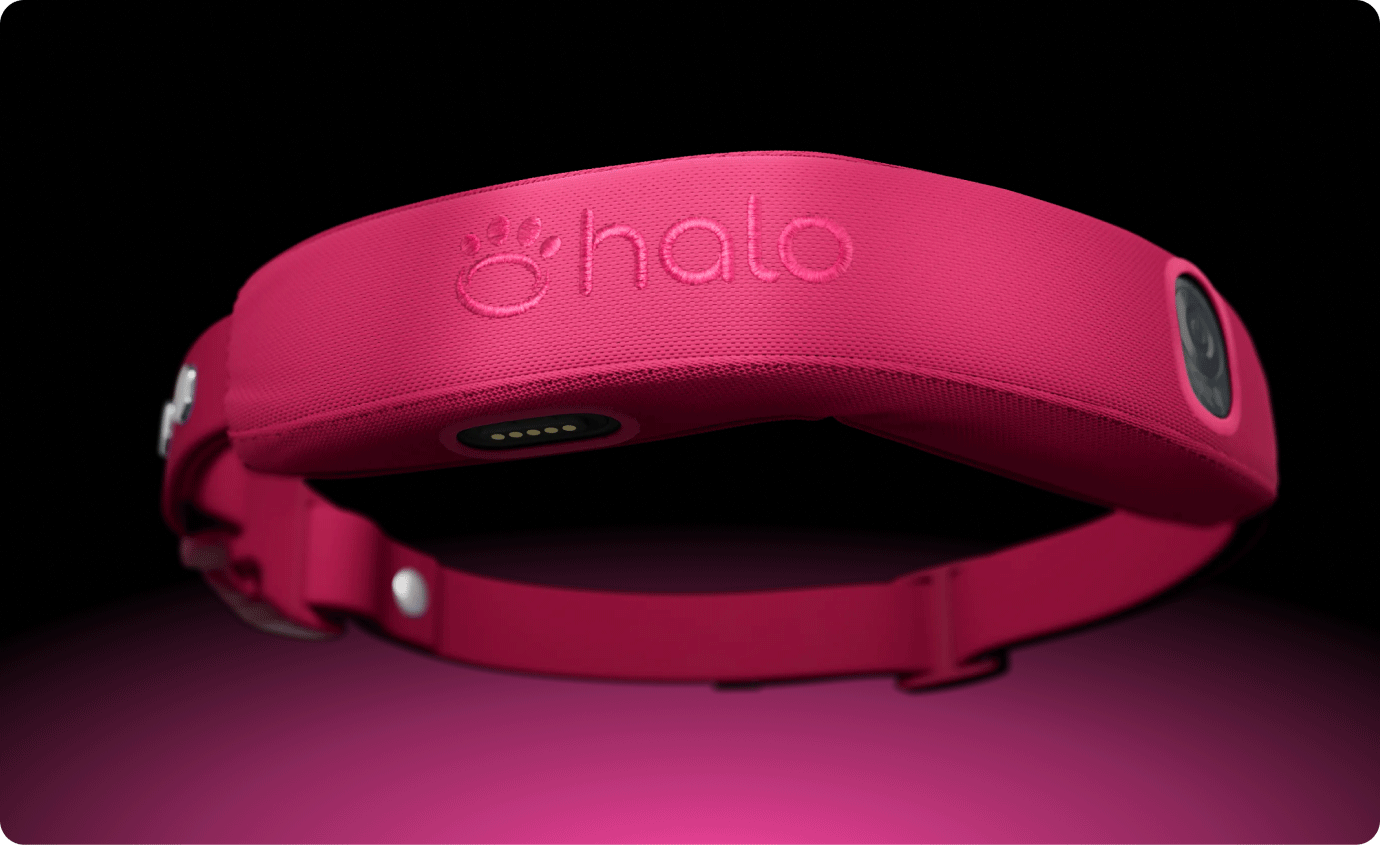
Keep your Great Dane Active and Safe With Halo Collar
There’s an old saying that a dog is our best friend for part of our lives but we are our dog’s best friend their entire lives. That’s why it’s important to maximize every minute you have with your best friend. Halo Collar is a wireless GPS fence that allows you to set up a safe perimeter for your dog at home, or while out and about. It also acts as an activity tracker and training aid for your Great Dane. Shop for your Halo Collar today.

